High Level Summary of Equality Statistics: Key Trends for Scotland 2006
The High Level Summary of Equality Statistics is a compendium which presents statistical trends on the main areas of Government activity in Scotland across a number of equality dimensions including age, disability, ethnicity, gender and in some cases religion. It provides a standardised, concise format for each topic and provides a route into more detailed statistics on each topic and each equality dimension by listing relevant publications and websites.
3. Labour Market
Introduction to the Labour Market and Equality
This section of the High Level Summary of Equality Statistics ( HLSES) presents key information on Scotland's labour market across a number of equality dimensions including age, disability, ethnicity, gender and religion. It reflects key areas of activity identified in the main High Level Summary of Statistics chapter on the labour market ( http://www.scotland.gov.uk/Topics/Statistics) from an equalities perspective and includes a few additional topics where these are particularly relevant to equality issues. Where the main HLSS publication presents data by any of these equality dimensions, these are also shown here for ease of reference.
As well as showing key high level trends, the analysis highlights where differences and potential areas of inequality may exist in Scotland's labour market for those groups outlined above. The analysis is not intended to provide a definitive set of equalities data and more detailed statistics across the equality dimensions, where available, are referenced in the links provided. It is also not possible to break down all topics by all equality dimensions.
There are limitations in how far some data can be broken down by the above equality dimensions. Data taken from sample surveys often contain small numbers, particularly in the case of smaller ethnic groups and to some extent disability. As such, some data are prone to sampling error and trends based on such data often show a high degree of volatility. In such instances, data may have been combined for multiple years or multiple ethnic groups, whilst in other cases data may be shown for a single year only. In other instances small data may have been suppressed in order to protect individuals' confidentiality.
Possible reasons underlying the differences reported in this chapter are not detailed here. Factors which contribute to differences between equality groups represent a complex interplay of cultural, demographic and socio-economic factors and, as such are outwith the scope of this publication.
Employment and Economic Activity
Scotland's Economic Activity
Scotland's Economic Activity: Gender
Scotland's labour market has been performing well in recent years, with more individuals in employment than ever before. Between 1999 and 2006 economic activity rates and employment rates have been consistently high for both men and women and have increased steadily for both groups. In 2006, 77.2% of males and 72.1% of females are in employment.
Female employment rates rose from 67.5% in 1999 to 72.1% in 2006. Despite this, female economic activity and employment rates remain more than 5 percentage points lower than for males in 2006, although this gap had narrowed slightly since 1999.
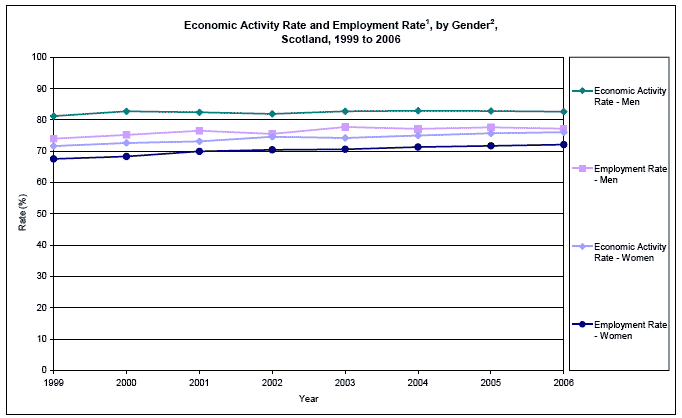
Source: Labour Force Survey, Spring Quarters (March to May)
Notes: 1. Includes males and females in part-time and full-time employment.
2. Rates are for females aged 16-59 years and males aged 16-64 years.
Publications
Social Focus on Women and Men 2002 http://www.scotland.gov.uk/stats/sfwm/docs/sfwm-00.asp
Annual Population Survey in Scotland, 2005 http://www.scotland.gov.uk/Publications/2006/06/28140032/0
Scotland's Economic Activity: Ethnic Group
In 2005, adults from minority ethnic groups have a markedly lower employment rate (58%) than those from white ethnic groups (75%); a difference of 17 percentage points 1. A similar difference can be observed for economic activity rates. Correspondingly, people from minority ethnic groups have higher economic inactivity rates (37%) than people from white ethnic groups (20%) 1.
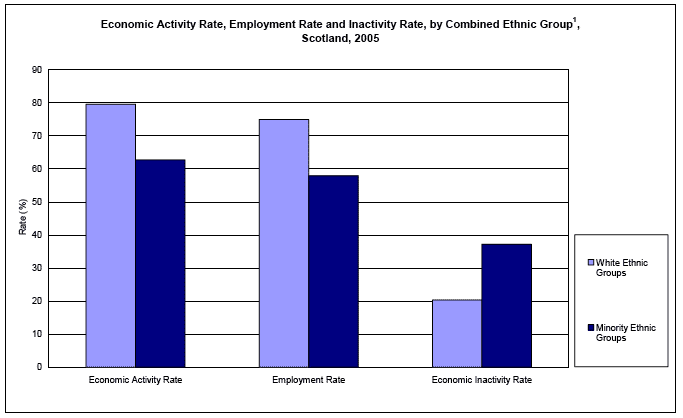
Source: Annual Population Survey in Scotland, 2005
Notes: 1. Rates for minority ethnic groups are based on small sample sizes and as such, these data are subject to a high degree of sampling error.
2. Rates are for females aged 16 to 59 year and males aged 16 to 64 years.
Publications
Analysis of Ethnicity in the 2001 Census - Summary Report http://www.scotland.gov.uk7ff5ee0f-3801-4607-b42e-2fbe7a66bf2d
Annual Population Survey in Scotland, 2005 http://www.scotland.gov.uk/Publications/2006/06/28140032/0
Scotland's Economic Activity: Religion Group
In 2001, Muslims are the least likely to be economically active with just over half (52%) of those of working age being in employment or unemployed and seeking employment. Sixty-four per cent of both Sikhs and Buddhists are economically active. Seventy-six per cent of people who report their religion to be Church of Scotland are economically active and this is followed closely by Roman Catholics, 71% of whom are economically active.
Muslims have the highest unemployment rate at 13%. This is followed by Buddhists and those reporting Another Religion with 11% of both groups unemployed. The lowest unemployment rate is for the Jewish group at 5%. People from the Church of Scotland and Other Christian groups also have low rates of unemployment at 6%. Eight per cent of Roman Catholics were unemployed.
Of all religious groups, Muslims are most likely to have never worked (30%), followed by Sikhs (18%) and Hindus (14%). The proportion of people having never worked is lowest for those identifying as Church of Scotland (4%) followed closely by Other Christian and Another Religion (5% for both groups) and Roman Catholic (6%).
It should be noted that there is an effect of gender on employment and unemployment rates (economic activity) for different religion groups shown below. This is most notable for males and females in the Muslim religion group. According to the 2001 Census, around two-thirds of Muslim men (67%) are economically active, while only 35% of Muslim women are in employment or unemployed (but still seeking employment) . There are also large differences between Hindu and Sikh men and women in terms of their economic activity rates.
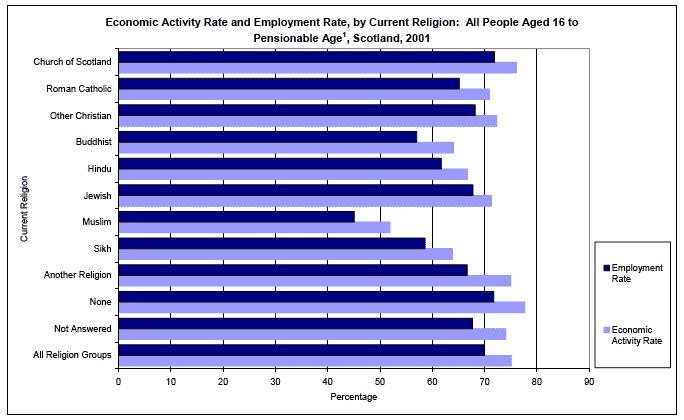
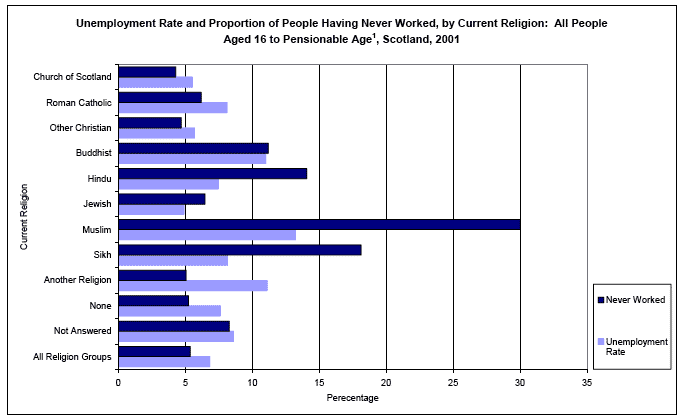
Source: General Register Office for Scotland ( GROS) - 2001 Census
Note: 1. The age band '16 to Pensionable Age' refers to females aged between 16 and 59 years and males aged between 16 and 64 years. This is based on the state pension age in 2001 when the Census data were collected.
Publication
Analysis of Religion in the 2001 Census http://www.scotland.gov.uk/Publications/2005/02/20757/53567
Web Link
General Register Office for Scotland ( GROS) http://www.gro-scotland.gov.uk/
Scotland's Economic Activity: Disability
In 2006, the employment rate for non-disabled adults (82%) is considerably higher than for disabled adults (48%), although this gap has narrowed slightly by 7 percentage points since 1999, at which time the employment rate for disabled adults was 38%, compared to 79% for non-disabled adults. Employment rates have continued to increase steadily for both groups during this time. As would be expected, trends in economic activity show a similar pattern.
In 2006, inactivity rates are almost four times as high for disabled adults (48%) than for non-disabled adults (13%). Inactivity rates have decreased steadily for both groups since 1999, though this has been most marked for disabled adults.
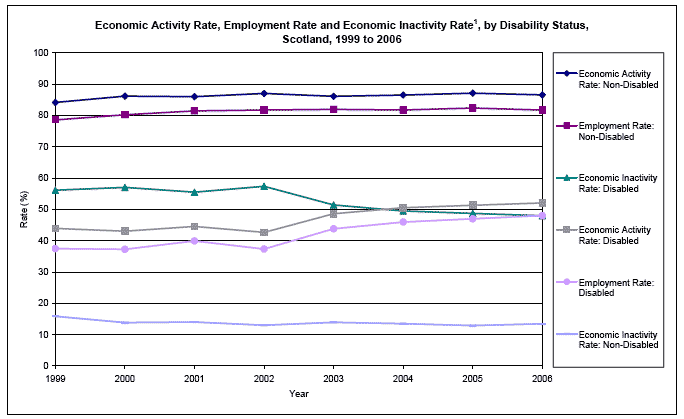
Source: Labour Force Survey, Spring Quarters (March to May)
Note: 1. Rates are for females aged 16 to 59 years and males aged 16 to 64 years.
Publications
Social Focus on Disability 2004 http://www.scotland.gov.uk/Publications/2004/08/19818/41697
Annual Population Survey in Scotland, 2005 http://www.scotland.gov.uk/Publications/2006/06/28140032/0
Scotland's Economic Activity: Gender
In 2006, the employment rate for men in full-time employment (71%) is markedly higher than for females (43%). Conversely, the employment rate for females in part-time employment (28%) is markedly higher than for males (7%). Since 1999, these gender differences have remained fairly constant, although they have started to narrow slightly in more recent years.
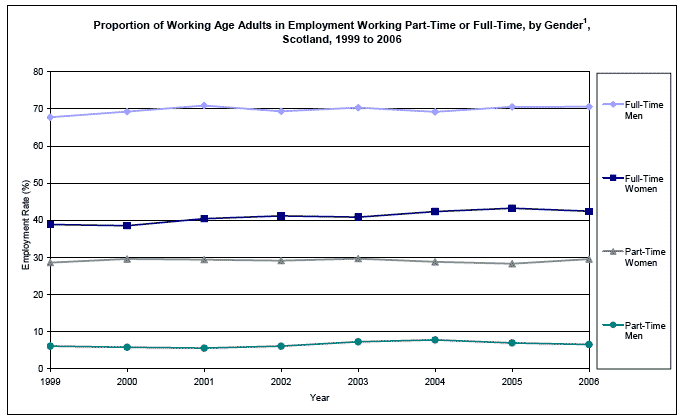
Source: Labour Force Survey, Spring Quarters (March to May)
Note: 1. Rates are for females aged 16 to 59 years and males aged 16 to 64 years.
Publications
Social Focus on Women and Men 2002 http://www.scotland.gov.uk/stats/sfwm/docs/sfwm-00.asp
Annual Population Survey in Scotland, 2005 http://www.scotland.gov.uk/Publications/2006/06/28140032/0
Scotland's Economic Activity: Age
In 2006, the employment rate for those age groups between 25 and 54 years are very similar at around 80%, whilst for those aged between 16 and 24 years and 55 and 59/64 years it is around 60%. Since 1999, the employment rate has increased most markedly for those aged 55 to 59/64 years (a rise of almost 8 percentage points), whilst it has increased more marginally for the remaining age groups.
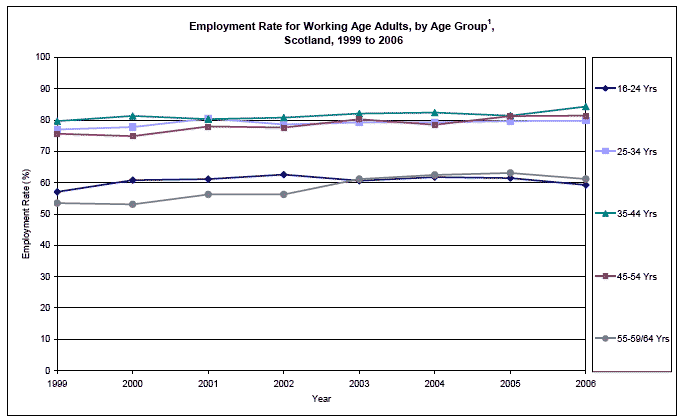
Source: Labour Force Survey, Spring Quarters
Note: 1. The age band '55-59/64' refers to females aged 55 to 59 years and males aged 59 to 64 years.
Publication
Annual Population Survey in Scotland, 2005 http://www.scotland.gov.uk/Publications/2006/06/28140032/0
Earnings
The earnings data below show median earnings and mean earnings. Median earnings is the preferred average earnings measure as the earnings distribution is heavily skewed and the median is not affected by a few people with extremely high earnings to the same degree as the mean is. Mean earnings, however, are used to monitor the gender pay gap internationally.
Earnings: Median Hourly Pay: Gender
In 2006, median hourly pay for adults in full-time employment is 10% lower for females (£10.00) than for males (£11.13). There is virtually no difference between median hourly pay for part-time employment, with females earning £7.00 and males earning £6.97.
In 1999, median hourly pay for females in full-time employment was 17% lower for females than for males and by 2003 this had narrowed to 13%. Since 2004 the gap has continued to narrow and in 2006 median hourly pay for females is 10% lower than for males. Figures for 2004 onwards are not comparable with previous years 1.
In 1999, median hourly pay for females in part-time employment was 6% lower for males than for females and by 2003 this had narrowed to 0.3%, similar to the size of the gap in 2006 (0.4%).
Between 1999 and 2006 median hourly pay (£) has increased substantially for male and females in both part-time and full-time employment. The largest proportion increase in median hourly pay is for males in part-time employment up by 52% from £4.88 in 1999 to £6.97 in 2006.
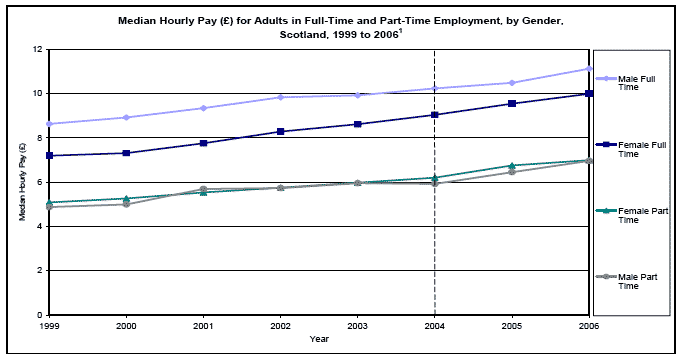
Source: Office for National Statistics - Annual Survey of Hours and Earnings
Notes:
1. To improve coverage and hence make the survey more representative, supplementary information was collected from the 2004 ASHE survey onwards. The 2004 and 2005 results are therefore discontinuous with the results of 2003 and previous years, for which no supplementary information was collected.
Publications
Social Focus on Women and Men 2002 http://www.scotland.gov.uk/stats/sfwm/docs/sfwm-00.asp
Annual Survey of Hours and Earnings http://www.statistics.gov.uk/StatBase/Product.asp?vlnk=13101
Earnings: Mean Hourly Pay: Gender
In 2006, mean hourly pay for adults in full-time employment is 14% lower for females (£11.77) than for males (£13.63). Mean hourly pay for adults in part-time employment is 12% lower for females (£8.89) than for males (£10.10).
In 1999, mean hourly pay for females in full-time employment was 19% lower than for males and by 2003 this had narrowed slightly to 18%. Since 2004, the pay gap has narrowed further and in 2006 mean hourly pay for females is 14% lower than for males. Figures for 2004 onwards are not comparable with previous years 1.
In 1999, mean hourly pay for females in part-time employment was 1% lower for females than for males and by 2003 this gap had increased to 4%. In 2006, mean hourly pay for females in part-time employment is 12% lower for females than males.
Between 1999 and 2006 mean hourly pay (£) has increased substantially for males and females in both part-time and full-time employment. The largest proportion increase in mean hourly pay is for males in part-time employment up by 55% from £6.51 in 1999 to £10.10 in 2006.
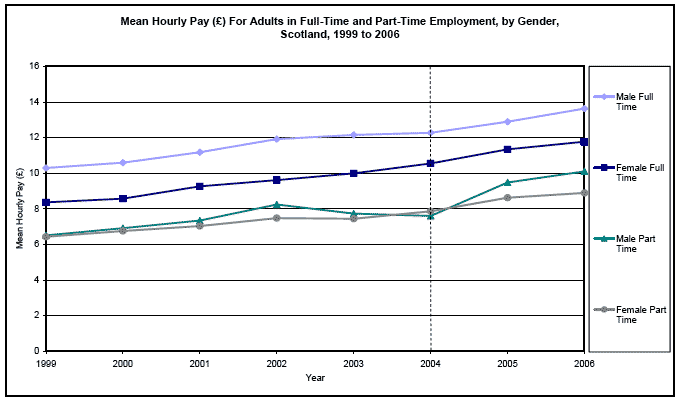
Source: Office for National Statistics - Annual Survey of Hours and Earnings
Note:
1. To improve coverage and hence make the survey more representative, supplementary information was collected from the 2004 ASHE survey onwards. The 2004 and 2005 results are therefore discontinuous with the results of 2003 and previous years, for which no supplementary information was collected.
Publications
Social Focus on Women and Men 2002 http://www.scotland.gov.uk/stats/sfwm/docs/sfwm-00.asp
Annual Survey of Hours and Earnings http://www.statistics.gov.uk/StatBase/Product.asp?vlnk=13101
Earnings: Median Weekly Pay: Disability
In 2006, the average median weekly pay of full-time employees was estimated to be 5% higher for non-disabled adults (£375) than for disabled 1 adults (£357). By comparison disabled adults were estimated to earn £250 per week in 1999, compared to £288 for non-disabled adults, a pay gap of 15% 2,3.
Source: Labour Force Survey ( LFS), Spring Quarters
Notes: 1. The LFS questions on health and disability reflect the provisions of the Disability Discrimination Act ( DDA) 1995. The LFS broadly classifies disabled into three categories records: DDA disabled (current disabled) only - who have a current disability which includes people who have a long-term disability which substantially limits their day-to-day activities; Work-limiting disabled - people who have a long-term disability which affects the kind of work or amount of work they might do; and a third category where respondents have both.
2. The Annual Survey of Hours and Earnings ( ASHE) is the preferred source of estimates of earnings, however questions on disability are not asked in the ASHE.
3. Pay estimates are based on small sample sizes and as such, these data are subject to a high degree of sampling error.
Publications
Social Focus on Disability 2004 http://www.scotland.gov.uk/Publications/2004/08/19818/41697
Annual Population Survey in Scotland, 2005 http://www.scotland.gov.uk/Publications/2006/06/28140032/0
Benefits Claimants
Working Age Key Benefits Claimants: Gender
In 2005, the proportion of adult males and females claiming key benefits is very similar (at just under 9%). The proportion has decreased steadily for both groups since 1999, though this is most marked for males (a fall of 1.3 percentage points).
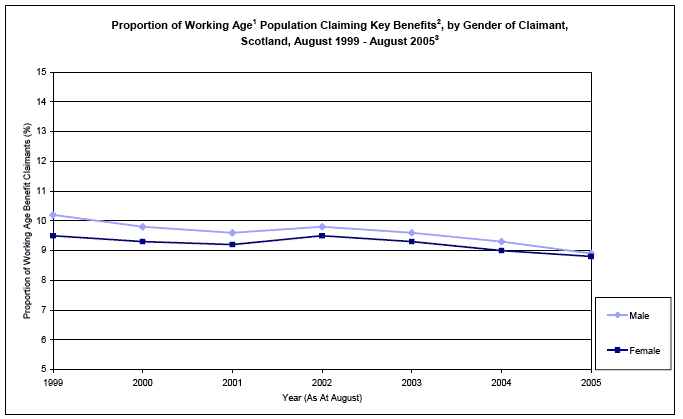
Source: Department of Work and Pensions ( DWP) Information Directorate: Work and Pensions Longitudinal Study - as at August
Notes: 1. Males aged 16 to 64 years and females aged 16 to 59 years.
2. Key benefits include; Jobseekers Allowance ( JSA), Income Support ( IS) (including Pension Credit for males aged 60-64 from 2003 onwards), Incapacity Benefit ( IB), Severe Disablement Allowance ( SDA), Disability Living Allowance ( DLA) (from May 2002), Carer's Allowance ( CA), Bereavement Benefits ( BB)/ Widow Benefits ( WB) and National Insurance Credits through JSA and IB.
3. Time series benefit figures are affected by the introduction of Child Tax Credit from April 2003.
Publication
Social Focus on Women and Men 2002 http://www.scotland.gov.uk/stats/sfwm/docs/sfwm-00.asp
Web Link
Department of Work & Pensions ( DWP) Tabulation Tool http://www.dwp.gov.uk/asd/tabtool.asp
Working Age Key Benefits Claimants: Age
In general, the proportion of adults claiming key benefits 1 tends to increase with age, although it is similar for those aged between 22 and 45 years.
In 2005, 11% of working age adults between 16 and 21 years are claiming key benefits, compared to 36% of those aged between 61 and 64 years 2. There is little fluctuation among those aged between 22 and 45 years for whom the proportion claiming key benefits varies between 14% and 16%.
With the exception of those aged 22 to 26 years, the proportion of people claiming key benefits has decreased for all age groups since 1999, with the largest fall being for those aged between 61-64 years (down from 44% in 1999 to 36% in 2005).
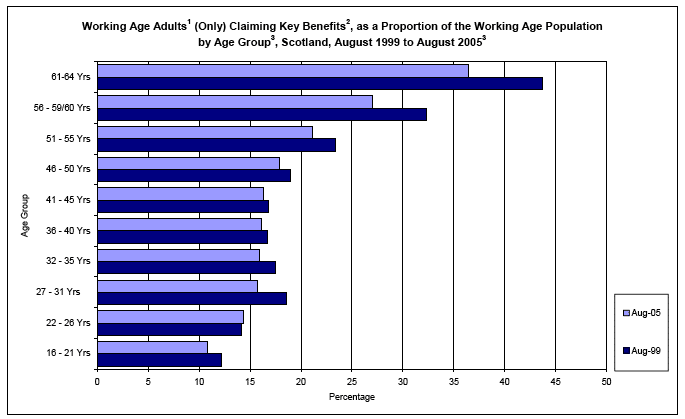
Source: Department of Work and Pensions: Information Directorate - Work and Pensions Longitudinal Study ( WPLS) - as at August
Notes: 1. Key benefits include; Jobseekers Allowance ( JSA), Income Support ( IS) (including Pension Credit for males aged 60-64 from 2003 onwards), Incapacity Benefit ( IB), Severe Disablement Allowance ( SDA), Disability Living Allowance ( DLA) (from May 2002), Carer's Allowance ( CA), Bereavement Benefits ( BB)/ Widow Benefits ( WB) and National Insurance Credits through JSA and IB.
2. Those aged 61-64 year include males of working age only. The age band `56- 59/ 60 Yrs' refers to females aged between 56 and 59 years and males aged between 56 and 60 years i.e. based on those who would still be working according to state pension age at the time.
3. Time series benefit figures are affected by the introduction of Child Tax Credit from April 2003.
Web Link
Department of Work & Pensions ( DWP) Tabulation Tool http://www.dwp.gov.uk/asd/tabtool.asp
Working Age Key Benefits Claimants: Ethnic Group
In 2005, the proportion of the working age population 1 claiming key benefits 2 is slightly higher for white ethnic groups (13.9%) than for minority ethnic groups 3 (9.8%).
Source: Annual Population Survey in Scotland 2005 (January - December).
Notes: 1. Refers to males aged between 16 and 64 years and females aged between 16 and 59 years.
2. Key benefits include: Unemployment related benefits, National Insurance credits , Income Support (not as unemployed person) and Sickness or disability benefits (excluding Disabled Persons Tax Credit).
3. Figures for minority ethnic groups are based on small sample sizes and as such, these data are subject to a high degree of sampling error.
Publication
Analysis of Ethnicity in the 2001 Census - Summary Report http://www.scotland.gov.uk7ff5ee0f-3801-4607-b42e-2fbe7a66bf2d
Web Link
Annual Population Survey in Scotland, 2005 http://www.scotland.gov.uk/Publications/2006/06/28140032/0
Working Age Key Benefits Claimants: Gender & Deprived Areas
The data outlined below are based on the Scottish Index of Multiple Deprivation 2006.
The proportion of both male and female working age adults claiming key benefits who reside in the 15% most deprived areas of Scotland is markedly higher than for males and females living in the rest of Scotland.
In 2005, 39% of males residing in the 15% most deprived areas are claiming key benefits, compared to 13% of those residing in the rest of Scotland. By comparison 35% of females residing in the 15% most deprived areas are claiming key benefits compared to 12% of those living in the rest of Scotland.
Since 1999, the proportion of both males and females claiming key benefits has decreased steadily for all areas, though this has been more marked for those residing in the 15% most deprived areas of Scotland.
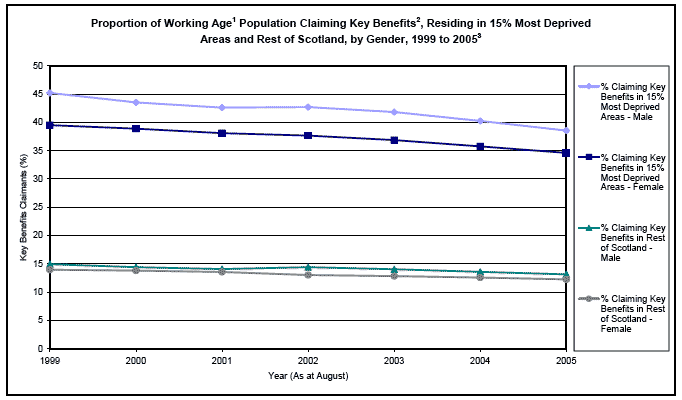
Source: Benefits Data: Department of Work & Pensions ( DWP)
Population Estimates: General Register Office for Scotland ( GROS)
Deprived Areas: Scottish Index of Multiple Deprivation ( SIMD) 2006
Notes: 1. Defined as males aged between 16 and 64 years and females aged between 16 and 59 years.
2. Key benefits include; Jobseekers Allowance ( JSA), Income Support ( IS) (including Pension Credit for males aged 60-64 from 2003 onwards), Incapacity Benefit ( IB), Severe Disablement Allowance ( SDA), Disability Living Allowance ( DLA) (from May 2002), Carer's Allowance ( CA), Bereavement Benefits ( BB)/ Widow Benefits ( WB) and National Insurance Credits through JSA and IB.
3. Time series benefit figures are affected by the introduction of Child Tax Credit from April 2003.
Publications
Social Focus on Women and Men 2002 http://www.scotland.gov.uk/stats/sfwm/docs/sfwm-00.asp
Social Focus on Deprived Areas 2005 http://www.scotland.gov.uk/SocialFocusOnDeprivedAreas
16-19 Year Olds Not in Employment, Education or Training ( NEET)
16-19 Years Olds NEET: Age
In 2005, the number of 16 to 19 year olds Not in Employment, Education or Training ( NEET) is approximately 36,000, equating to 14.0% of all those aged 16 to 19 years. For males aged 16 to 19 years, the NEET proportion was 14.6%, compared to 13.9% for females aged 16 to 19 years. There has not been a marked change in the NEET proportion in any year since 1996.
Reducing the proportion of 16-19 year olds Not in Employment, Education or Training is one of the Closing the Opportunity Gap targets.
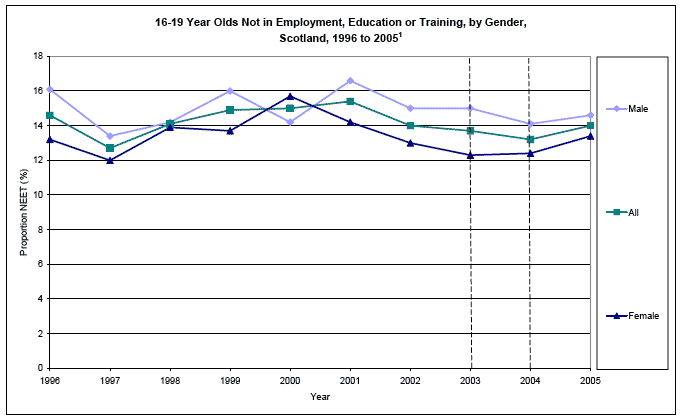
Source: Labour Force Survey ( LFS), quarters combined for 1996-2002. The 2003 figures are taken from the Annual Scottish LFS ( ASLFS). From 2004 onwards figures are taken from the Annual Population Survey ( APS). The APS and ASLFS include boosts to the main LFS. This means there is discontinuity in the series.
Publication
Social Focus on Women and Men 2002 http://www.scotland.gov.uk/stats/sfwm/docs/sfwm-00.asp
Web Link
Closing the Opportunity Gap Target B http://www.scotland.gov.uk/Topics/People/Social-Inclusion/17415/CtOG-targets/ctog-target-b
There is a problem
Thanks for your feedback